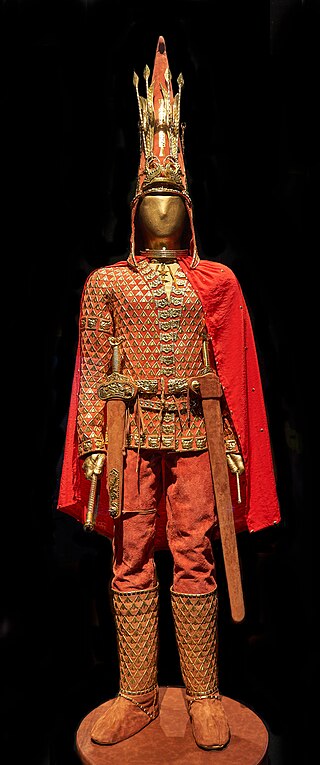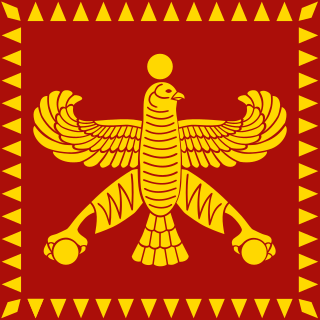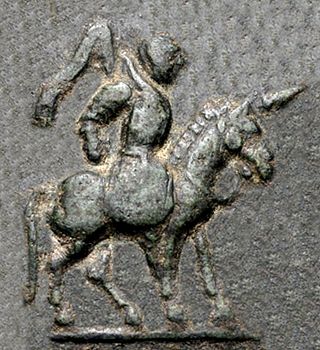
Bessus or Bessos, also known by his throne name Artaxerxes V, was a Persian satrap of the eastern Achaemenid satrapy of Bactria, as well as the self-proclaimed King of Kings of the Achaemenid Empire from 330 to 329 BC.

The Medes were an ancient Iranian people who spoke the Median language and who inhabited an area known as Media between western and northern Iran. Around the 11th century BC, they occupied the mountainous region of northwestern Iran and the northeastern and eastern region of Mesopotamia in the vicinity of Ecbatana. Their consolidation in Iran is believed to have occurred during the 8th century BC. In the 7th century BC, all of western Iran and some other territories were under Median rule, but their precise geographic extent remains unknown.

The Saka, Shaka, or Sacae were a group of nomadic Eastern Iranian peoples who historically inhabited the northern and eastern Eurasian Steppe and the Tarim Basin.

Cyaxares was the third king of the Medes. Cyaxares ascended to the throne in 625 BCE, after his father Phraortes lost his life in a battle against the Assyrians.

Cyrus II of Persia, commonly known as Cyrus the Great, was the founder of the Achaemenid Persian Empire. Hailing from Persis, he brought the Achaemenid dynasty to power by defeating the Median Empire and embracing all of the previous civilized states of the ancient Near East, expanding vastly and eventually conquering most of West Asia and much of Central Asia to create what would soon become the largest polity in human history at the time. Widely considered the world's first superpower, the Achaemenid Empire's largest territorial extent was achieved under Darius the Great, whose rule stretched from the Balkans and the rest of Southeast Europe in the west to the Indus Valley in the east.

The Massagetae or Massageteans, also known as Sakā tigraxaudā or Orthocorybantians, were an ancient Eastern Iranian Saka people who inhabited the steppes of Central Asia and were part of the wider Scythian cultures. The Massagetae rose to power in the 8th to 7th centuries BCE, when they started a series of events with wide-reaching consequences by expelling the Scythians out of Central Asia and into the Caucasian and Pontic Steppes. The Massagetae are most famous for their queen Tomyris's alleged defeating and killing of Cyrus, the founder of the Persian Achaemenid Empire.

Maues was the first Indo-Scythian king, ruling from 98/85 to 60/57 BCE. He invaded India and established Saka hegemony by conquering Indo-Greek territories.

Tomyris also called Thomyris, Tomris, or Tomiride, is known only from the Greek historian Herodotus. According to him, she reigned over the Massagetae, an Iranian Saka people of Central Asia. Tomyris led her armies to defend against an attack by Cyrus the Great of the Achaemenid Empire, and defeated and killed him in 530 BC. She had his severed head placed in a bag or bowl filled with blood, saying to it "There: drink your fill of blood!"

Margiana is a historical region centred on the oasis of Merv and was a minor satrapy within the Achaemenid satrapy of Bactria, and a province within its successors, the Seleucid, Parthian and Sasanian empires.

The Iranian languages, also called the Iranic languages, are a branch of the Indo-Iranian languages in the Indo-European language family that are spoken natively by the Iranian peoples, predominantly in the Iranian Plateau.

The Dahae, also known as the Daae, Dahas or Dahaeans were an ancient Eastern Iranian nomadic tribal confederation, who inhabited the steppes of Central Asia.

The Caspians were a people of antiquity who dwelt along the southwestern shores of the Caspian Sea, in the region known as Caspiane. Caspian is the English version of the Greek ethnonym Kaspioi, mentioned twice by Herodotus among the Achaemenid satrapies of Darius the Great and applied by Strabo. The name is not attested in Old Iranian.

Ariana was a general geographical term used by some Greek and Roman authors of the ancient period for a district of wide extent between Central Asia and the Indus River, comprising the eastern provinces of the Achaemenid Empire that covered the whole of modern-day Afghanistan, as well as the easternmost part of Iran and up to the Indus River in Pakistan. Ariana is the Latinized form of the Ancient Greek Ἀρ(ε)ιανή Ar(e)ianē, originating from the Old Persian word Ariyanem (Ariana) meaning 'the Land of the Aryans', similar to the use of Āryāvarta.
Skunkha, was king of the Sakā tigraxaudā, a group of the Saka, in the 6th century BC.

Spargapises was the son of queen Tomyris of the Massagetai.

Around 535 BCE, the Persian king Cyrus the Great initiated a protracted campaign to absorb parts of India into his nascent Achaemenid Empire. In this initial incursion, the Persian army annexed a large region to the west of the Indus River, consolidating the early eastern borders of their new realm. With a brief pause after Cyrus' death around 530 BCE, the campaign continued under Darius the Great, who began to re-conquer former provinces and further expand the Achaemenid Empire's political boundaries. Around 518 BCE, the Persian army pushed further into India to initiate a second period of conquest by annexing regions up to the Jhelum River in what is today known as Punjab. At peak, the Persians managed to take control of most of modern-day Pakistan and incorporate it into their territory.
Amytis of Media was a Queen consort of the ancient Persian Achaemenid Empire. She was the daughter of the Median king Astyages, and the wife of Cyrus II.
The names of the Scythians are a topic of interest for classicists and linguists. The Scythians were an Iranic people best known for dominating much of the Pontic steppe from about 700 BC to 400 BC. The name of the Scythians is believed to be of Indo-European origin and to have meant "archer". The Scythians gave their name to the region of Scythia. The Persians referred to all Iranic nomads of the steppes, including the Scythians, as Sakas. Some modern scholars apply the name Scythians to all peoples of the Scytho-Siberian world, but this terminology is controversial.
Saka campaigns of Cyrus the Great consists of campaigns against the Sakas. Initially he attacked and defeated the Amyrgian but was after defeated by Amorges's Queen. Then King Amorges allied with Cyrus the Great. Later on, Cyrus the Great launched a campaign against the Massagetaens. He was successful in defeating and killing Spargapises. In retaliation, Tomyris with her army and allies, avenged her son's death by defeating and killing Cyrus in a battle.

















